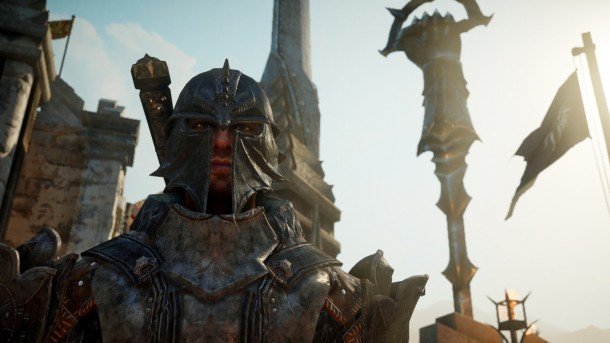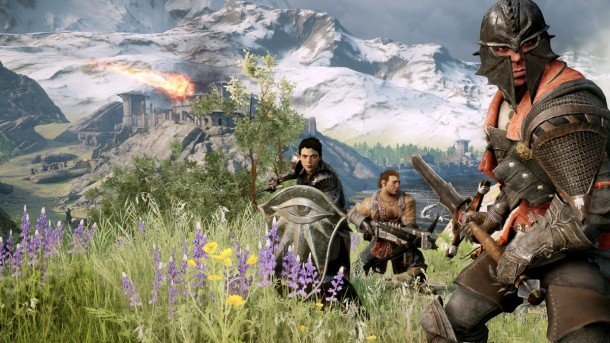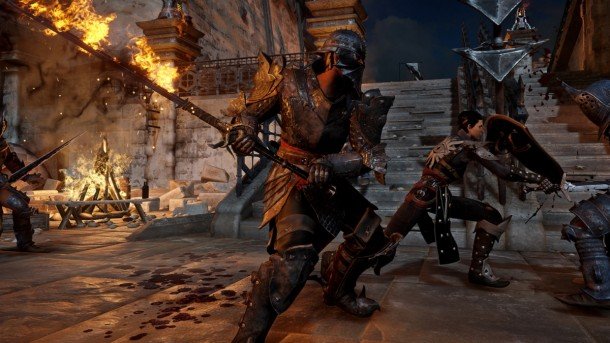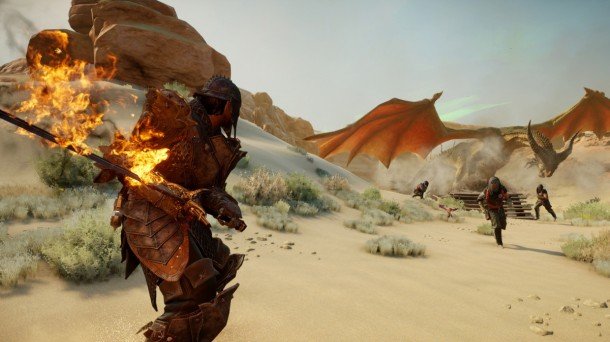Dragon Age Inquisition preview: fortresses, friendship and the Fade in BioWare's open world

After a long period of relative silence, information is finally creeping out about the shape and state of BioWare's next major RPG. I saw Dragon Age Inquistion at an EA event in London earlier in the week, the same information that will have - as of the time this goes live - just been revealed at PAX. Here's a rundown of my first impressions of the game - which, although it's more than a year from release, is looking far more fleshed out than I expected.
Plot and companions
Inquisition is set a few years after the events of the two previous games. The world is in the middle of several wars - civil war in Orlais, and the ongoing conflict between the mages and Templars - that are snowballing into one another: kind of like a fantasy World War I. At the start of the game, a massive dimensional tear opens between reality and the Fade - the dream dimension that is the source of magic and that you'll have visited once or twice if you played the previous games. In order to find out who is responsible for the fade tear, a new faction is formed with your character as its leader. This is the Inquisition, and the way it is founded reminds me of the description of the founding of the Grey Wardens - a trans-national pact to solve a problem that each individual faction can't solve by itself.

In the first game you were the Warden, in the second you were the Champion, and in the third you'll be the Inquisitor. You'll be able to choose your race from human, elf, dwarf, and - for the first time - qunari. BioWare weren't willing to spill any details on how your characters' origin will be fleshed out beyond that.
There'll be a range of companions, and BioWare stressed that this involves a "significant returning cast". The in-game demonstration confirmed the return of Dragon Age 2's Varric - the dwarven rogue who narrates the game - and Cassandra Pentaghast, the Chantry Seeker who interrogates that narration out of him. The fourth companion shown was Vivienne, an Orlesian mage who, based on a snippet of in-game dialogue, was once First Enchanter of one of the Circles there.
Combat
Combat is still based on a four-person party, and you can still control any individual member as well as pause time and zoom out into a full top-down view. The impact of spells and melee strikes inherits a lot from Dragon Age 2, but what I saw had a greater sense of weight and impact - there were no arbitrarily exploding torsos, for one thing. The new game has been built in the Frostbite engine, and environments are partially destructible. We were shown a wooden bridge being destroyed to send some archers tumbling to their deaths, and smaller scenery items - barrels, barriers etc - can be blown up or cast aside by magic.
The biggest gaming news, reviews and hardware deals
Keep up to date with the most important stories and the best deals, as picked by the PC Gamer team.
Tactics - the system by which friendly AI behaviours can be programmed - will return, and full friendly fire for magic will be an option for players that want it. Interestingly, health regeneration will be very limited: adventuring for any length of time will mean bringing healing supplies with you or having a mage with the right abilities on hand. It's nice to see these kinds of hardcore mechanics making their way back into mainstream RPGs, and it seems like a natural fit with the size of the world BioWare are creating.
Finally, content in the game won't scale with the player's level. This means that certain encounters or areas will be off-limits until the Inquisition's power grows. As someone who feels that scaling difficulty creates as many problems as it solves, I'm pretty excited about this change.

Conversations and consequences
Conversations are still dialogue-wheel based and the player character is fully voiced. Honestly, it looks a lot like Dragon Age II - but one cool new feature is the way that each option on the wheel has a corresponding tooltip offering more information on the potential consequences of that decision. The choice we were shown involved a party of injured guards wandering a road during an attack by a splinter faction of Templars. The player could order them to stay where they were, help a local village, or defend a nearby Inquisition keep.
Once you've made one of these decisions, it's up to you whether you try to mitigate their negative effects in the open world. You could, for example, tell your allies to abandon the village and then go and save it yourself - or tell the guards to stay with their wounded and attempt to relieve the siege single-handed. I like the degree of flexibility it suggests, as well as the way it'll hopefully force player decisions to result from the game's mechanics ("I don't have enough healing items to do this alone, I need these guards to help me") rather than a simple desire to play one type of hero or another.
The world...
...is looking big. Specifically, bigger than Dragon Age: Origins. Three years of development time and a decent budget look to have prevented DAII's geographical limitations from resurfacing. The game will be split into multiple large areas with each area containing a number of towns, fortresses, caves and dungeons. There were no loading screens within these zones during the demo I was shown, but there will be some kind of load when the party moves from one zone to another. I was shown an area in Ferelden that included a large lake as well as a desert area west of Orlais.
The broad area that the game will cover includes Ferelden, Orlais, Nevarra and the Free Marches. The map I was shown didn't extend as far north as Tevinter and Antiva or further south than Ferelden's Kocari Wilds. If you're a fan familiar with Thedas' layout then that should give you some idea of the scope, though I don't know exactly how many of these open-world zones there will be - nor how the game will handle cities. Nontheless, it feels fair to say that it's looking pretty big.
Each area has a number of fade tears - smaller portals to the Fade that the player will be expected to close. Think Oblivion Gates, basically, though what exactly is involved in closing a tear wasn't revealed. In Ferelden, one of these tears is in the middle of a lake - one solution, the devs suggested, involved using a nearby dam to permanently lower the water line.
Fortresses!
It seems like every province will include a fortress or two, and one of your main objectives when you arrive in new territory will be to claim an Inquisition stronghold. The presentation suggested that this will involve a range of side objectives - poisoning water supplies, etc - followed by a brief siege. Once you've captured a fortress, it'll change to reflect Inquisition ownership and the kind of outpost you want it to be. We were shown designs for a military fortress, an espionage centre, and a merchantile trading hub. Each will have its advantages and drawbacks and they'll additionally affect the kind of organisation the Inquisition will come to be - unlike the Wardens, whose identity is set in stone, you'll have some say over whether the Inquisition comes to be a merciless fighting force or something more subtle.

Taking a fortress then gives you access to a strategic metagame where you spend Inquisition agents to affect change in the world. The ones we were shown involved rebuilding monuments, opening paths to new areas, and establishing resource-gathering buildings to help with your crafting and alchemy. It made me think a little of Assassin's Creed: Brotherhood - a great open world game in its own right, and an influence I'm happy to see cropping up in a different genre.
Also, dragons.
BioWare seem to be really proud of their dragons. There'll be a fixed number of these in the game, and it sounds like they'll act as massive boss fights at the culmination of certain areas. They seem a little bit clumsy - they have a tendency to fly leg-first through pieces of tactically scattered ancient ruin, sending bricks and debris in their wake - but it's nonetheless very impressive. The brief segment we were shown reminded me of the original CGI trailer for Origins, where a dragon battle was a long, mobile, multi-stage affair. Here's hoping that some of that energy makes it into the actual game this time. In any case, expect to be shown BioWare's impressive dragon over and over again in the long year before release.
Joining in 2011, Chris made his start with PC Gamer turning beautiful trees into magazines, first as a writer and later as deputy editor. Once PCG's reluctant MMO champion , his discovery of Dota 2 in 2012 led him to much darker, stranger places. In 2015, Chris became the editor of PC Gamer Pro, overseeing our online coverage of competitive gaming and esports. He left in 2017, and can be now found making games and recording the Crate & Crowbar podcast.


